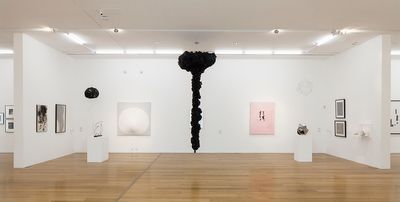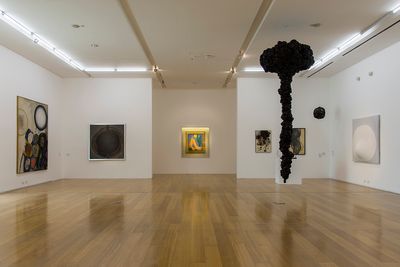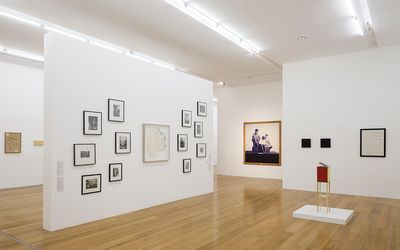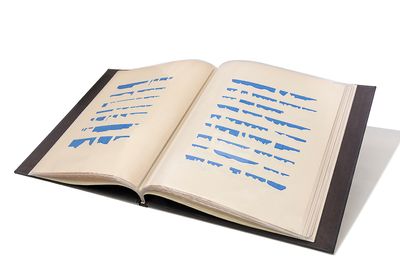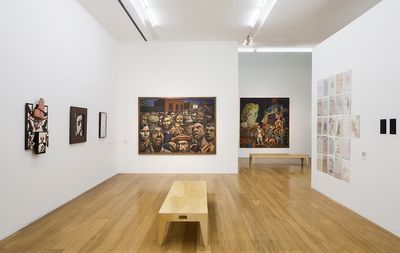Verboamérica at MALBA, Buenos Aires
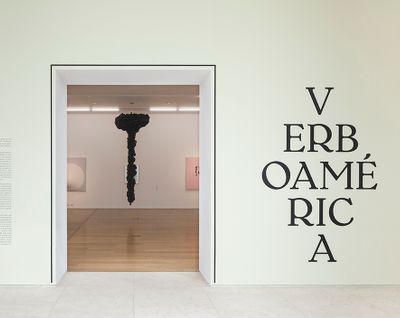
Installation view: Verboamérica, MALBA, Buenos Aires (16 September 2016–ongoing). Courtesy MALBA. Photo: Javier Augustin Rojas.
The exhibition situates some 170 seminal artworks from the museum's permanent collection within the framework of 'heterochrony', which rejects 'hegemonic modernity's unidirectional and linear notion of time' in favour of 'the perception of multiple alliances'.
The Latin American Art Museum of Buenos Aires, or MALBA, was founded in 2001 to house the collection of Argentine businessman Eduardo Costantini. Operated by the not-for-profit Fundación MALBA, the museum's collection focuses on artists from Latin America, such as Yeguas del Apocalipsis (Pedro Lemebel and Juan Francisco Casas), Alejandro Xul Solar, Alfredo Jaar, Diego Rivera and Ana Mendieta, and charts a history of artistic practices throughout the region, from the 20th century to the present. MALBA's current exhibition Verboamérica, which reflects a new staging of the museum's permanent collection that launched in September 2016, celebrates the museum's fifteenth anniversary. In keeping with the timely occasion, the exhibition situates some 170 seminal artworks from the museum's permanent collection within the framework of 'heterochrony', which rejects 'hegemonic modernity's unidirectional and linear notion of time' in favour of 'the perception of multiple alliances'.
The curators, historian and researcher Andrea Giunta and MALBA artistic director Agustín Pérez Rubio, are attentive to time as an agent of decolonisation, uncovering the varied faces of those Othered by a system that gains strength through alienation, including 'the South-colonial, black, migrant, female, queer, political, indigenous, censored, cannibal, disappeared,' and 'peripheral'. The exhibition's galleries are divided thematically, arranging its exhibits—which include the manifestos and journals of avant-garde movements from across the continent, such as Anthropophagy, Arturo, Neo-Concretism Peronism and Tropicália—into eight thematic 'non-consecutive episodes', giving the viewer the agency to pursue multiple paths of interpretation.
Upon entry, the chapter 'In the Beginning' immediately locates visitors within the reflexive, temporal architecture of León Ferrari's Hongo nuclear (Mushroom Cloud) (2006): a black polyurethane sculpture made up of an explosion of coiled clusters that hang like a mushroom cloud in the room. Monstrous, sublime, mystical and destructive at once, the work seems to refer to imminent apocalypse and urgency, while also harking back to the first explosion of new life forms, the independent ontology of the mushroom cloud itself, and creation myths. The sculpture's shadow, bulbous at the top and pointed at the bottom, begins to mirror the shape of the South American continent as it spreads out across the gallery. It is surrounded by other circular, oval and spherical works such as Mira Schendel's Disco Zero (1971), setting up a narrative of simultaneous creation and destruction.
Immediately to the left of this section is another titled 'Indigenous America, Black America', which includes a grouping of works by artists such as Frida Kahlo, Claudia Andujar, Ana Mendieta, and Jesús Ruiz Durand. Preceding this section is a painting by the canonised Brazilian artist, Tarsila do Amaral, Abaporu (1928). In the now extinct native Tupi language of Brazil, Abaporu means cannibal, and the painting shows an unadorned man-eating giant sitting beside a three-frond cactus and a sun rising against a blue background. It was this image that inspired the artist's partner, poet, and polemicist José Oswald de Souza Andrade, to write the 'Anthropophagite Manifesto' in 1928, which used cannibalism as an extended metaphor for swallowing European hegemonic culture and transforming it into something distinctly Brazilian/Latin American.
Artist Hélio Oiticica joined Grupo Frente in 1955 as a rejection of Amaral's pictorialism and the mural aesthetic of Riviera, condemning it as excessively nationalistic and vulnerable to pawning for governmental propaganda. In the section 'City, Modernity, and Abstraction', works include Montevideo-based artist Rafael Barradas' Calle vibracionista (1920) and Horacio Coppola's Calle Florida (1936/2005), along with many other photographs of Buenos Aires by Coppola, which capture the frenetic energy of cities both in ruin and ripe for rejuvenation through the play of form. Oiticica's B29 Bólide-caixa 16 (variation on Rocket-box 1) (1965–1966), is also on view. A medium-sized wooden box with its sides painted in primary colour monochromes, B29 Bólide-caixa 16 (1965) is a clear ode to Mondrian—its open base rests on a piece of glass set on legs that hold a mirror in place, such that the stones and gravel within are only viewable via this mirror. The piece exemplifies the Neo-Concrete belief that the experience of art is unruly and subject to the whimsy of the viewer; a rejection of geometric abstraction's rationalism. Still, B29 Bólide-caixa 16 stands in the impossible territory between obsequious and defiant, limited by its own structure, even as Oiticica utilised it as a means to think outside of it.
The city is also represented as a manifestation of inner life in the Argentian artist Mirtha Dermisache's asemic writing. Her original Libro Nº6 (Book No. 6) (1971), is displayed in a cluster of works grouped under the title 'Lettered City, Violent City, Imagined City'. Influenced by Barthes but filtered through Dermisache's experience in Buenos Aires in the aftermath of a decade of Peronist censorship and in a time of military dictatorship and civil unrest, Libro Nº6 is an intimate ode to mark-making. Devoid of letters, an invented language emerges out of word-length blocks of sky blue graphics. Each block is exactly top aligned, so that the lines take on a semblance of a script, bound by an imposed order. Every page is different, though on the outset, the inscriptions appear to be maps or surveys. Considering the period of extreme turbulence in which the artist created Libro Nº6, the book is a codified archive of imagined freedom.
If Dermisache created a unique, artificial language, Magdalena Jitrik utilises negative space to excavate the ghosts of the written word. Her piece, Federación Libertaria Argentina (Argentine Libertarian Federation) (1997–2001) is on view in the exhibition chapter, 'Work, Crowd, and Resistance'; it consists of four sheets of Jitrik's research into the history of anarchism through the story of the eponymous organisation, plus six photographs on wood of her site specific installation taken in this historical place. Blocks of abstract black ink are overlaid on the text. The practice of erasure utilises an existing text and makes it disappear in measures. What is left behind does not simply refer to what was; it comes to assume an identity of its own, like a body that speaks about absence and loss. The process by which each sheet is rendered appears to have been on of gruelling repetition, repositioning, and obverse censorship. Still, Federación Libertaria Argentina does not attempt to simply be an analytic alienation of meaning, but rather a synthetic tendency in which feeling is uncovered.
The chapter 'Country and Outskirts' comes as a refreshing break from the abstraction of the previous rooms and attests to the subtlety with which the works from MALBA's collection are held together in Verboamérica's frame, so that the variance between conceptual and figurative establishes an active tension within the curatorial design itself. The analogue process displayed in Eduardo Gil's medium format, colour-slide photograph, Splitting Patagónico (Patagonic Splitting) (2006), is in keeping with the scene it depicts. Beneath an un-manipulated, darkening sky, a prefabricated slum located in a settlement near Rio Grande in Tierra del Fuego is almost upturned in the high winds, a place 'where the dazzling city turns into waste, trauma and precariousness'. Amid dented tin, corrugated cardboard and the dispossession of rust and broken beams is a single gold and mauve shower curtain that curls around its rod, both supported by and entangled in itself. The transverse view of the interior means that the dwellings' fourth wall is open to the viewer, so that they become the missing side, complicit in the scene that is viewed.
A similar complicity is invoked in the room 'Bodies, Affects, and Emancipation', where Paz Errázuriz's photographs from the wake of the brutal Pinochet regime, in which tens of thousands went missing and whose human rights violations are still being uncovered, are on view. A visceral evocation of Nan Goldin's Ballad of Sexual Dependency, the images from her photobook La manzana de Adán (Adam's Apple) (1990), capture Mercedes, Evelyn and Pilar, three transvestites who lived double lives in the brothels of Santiago head on.
Within MALBA's white walls, Verboamérica manages to subvert the institutional frame while paying art historical homage to Latin America's history of anarchy, dissent and resistance. This exhibition does not simply span some of the pivotal artistic movements across Latin America in the last century; it invites the viewer to re-look, re-write, undermine, and participate in their redefinition in the present. Its main argument is situated in the section called 'Maps, Geopolitics and Power', where Joaquín Torres-García's famous ink-drawing América invertida (America Inverted) (1943) is a map that repositions South America in a way that shows Uruguay, the artist's home country, at the Equator, Ecuador at the Tropic of Cancer, and the Southern tip of the continent pointing north, thus renegotiating the terms by which the 'South' is regarded. The continent is seen uncut by borders, held only by a sun, moon, stars, a ship and a fish: important pre-Columbian symbols of direction. The piece shifts our preconceived notion of Cartesian time and reorients us in space: how can history be rewritten? A new imagination of a collective common gives way to a utopia of meaning. —[O]

